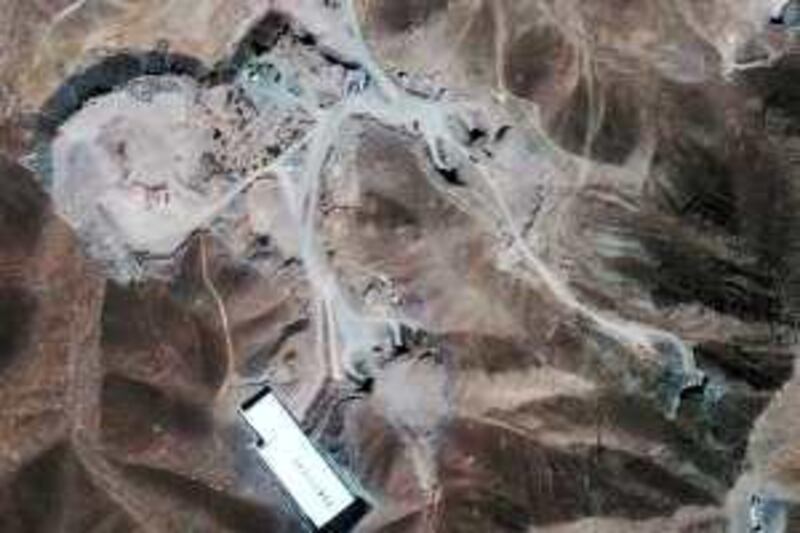Iran reiterated last month that it was not planning to build a nuclear warhead after it disclosed a secret uranium enrichment site near Qom, 150km south of Tehran. Debate has raged since then over whether the site, which Iran has said will be opened to inspection, was or is being used for weapons production. Regardless of the purposes of the Qom facility, for the United States, Israel and much of the international community, the issue is less a matter of if Iran is developing a nuclear weapon, than when it will have one - and predictions regarding that date are numerous and ever-changing.
The United States said in 1992 Iran would have a nuclear weapon within five years, a timeline that was repeated on a number of occasions over the following years. In 2005, a US National Intelligence Estimate said Iran was probably a decade away from having a nuclear weapon, before the latest NIE, in December 2007, said it could have one as early as 2010. But a report by the US state department's Bureau of Intelligence and Research that was made public in August said that date was more likely to be 2013 - at the earliest.
Israel, which has similarly overestimated the speed with which Iran was alleged to be preparing a nuclear weapon, estimates that Iran will have the bomb by 2014, according to a briefing that Meir Dagan, the head of the country's intelligence agency, Mossad, gave to a Knesset committee in June. Making a realistic estimate of when Iran could have a nuclear weapon is not helped by the almost daily news reports quoting the various predictions of "unnamed sources".
A report in Germany's Stern magazine in June, for instance, quoted an unidentified official at the country's BND intelligence agency saying Iran could detonate a nuclear weapon within six months. This was quickly rebutted by a spokesman for the BND who told the Bloomberg news agency that Germany estimated that Iran would not have a nuclear weapon before 2013, in line with US estimates. In August, a former senior official with the International Atomic Energy Agency (IAEA), Yousri Abu Shadi, said in an interview with Channel 1, an Egyptian television station, that Iran would have a nuclear weapon within two years.
Indeed, it could be argued that the IAEA, the UN's nuclear monitor, and its officials are responsible for much of the confusion surrounding this issue. Mohammed ElBaradei, the agency's outgoing director general, said in 2007 there was no "concrete evidence" Iran was developing, or planning to develop, a nuclear weapon. In June, Mr ElBaradei said in an interview with the BBC it was his "gut feeling" that Iran "would like to have the technology to enable it to have nuclear weapons, if it decides to do so".
In July, the man who will take over from Mr ElBaradei in November, Yukiya Amano, told Reuters he did not see "any evidence" Iran was trying to gain the ability to develop nuclear arms. Then last month, the Associated Press obtained a classified IAEA document saying the agency does believe Iran is working on a weapon capable of carrying a nuclear payload and is engaged in "probable testing" of explosives commonly used to detonate a nuclear warhead, among other findings. Mr ElBaradei was accused of withholding the report, which he denied.
According to the Institute for Science and International Security, a Washington body whose reports are consulted by governments and research institutes in matters of nuclear weapons proliferation, Iran has had since February a sufficient amount of low-enriched uranium to theoretically produce a bomb in three to six months if that uranium, currently under IAEA monitoring, were diverted and further enriched.
For that to happen, however, said Jacqueline Shire, a senior analyst at the institute, Iran would have to withdraw from the Non-Proliferation Treaty and kick out IAEA inspectors from the country - both of which would raise international alarm bells - and among other things, not encounter delays or further technical hurdles in the enrichment and weaponisation process. Ms Shire said a more realistic timeframe for Iran to get a weapon, if indeed that is its intention, would be some time between 2010 and 2013. If Iran were not to divert the enriched uranium from Natanz, it would need another source of uranium to enrich at a clandestine facility.
"We're not waving a flag saying Iran has a bomb," Ms Shire said. "But we're watching carefully." Iran is the most heavily IAEA-inspected country in the world, a point underlined by Gary Sick, an Iran analyst at Columbia University in New York. "Use of the present enrichment facilities to produce bomb-grade uranium would certainly be noticed and reported," Prof Sick writes on his website (http://garysick.tumblr.com/). "It is an early warning system."
In any case, it would take Iran "several years" to produce a weapon, according to Prof Sick, and that is not accounting for the measures that would inevitably be taken by the international community. "That period, which is apt to be several years, would be the true case of the ticking time bomb, and that would be the moment for consideration of extreme pressure tactics, probably with very wide support in the international community."
@Email:jspollen@thenational.ae





